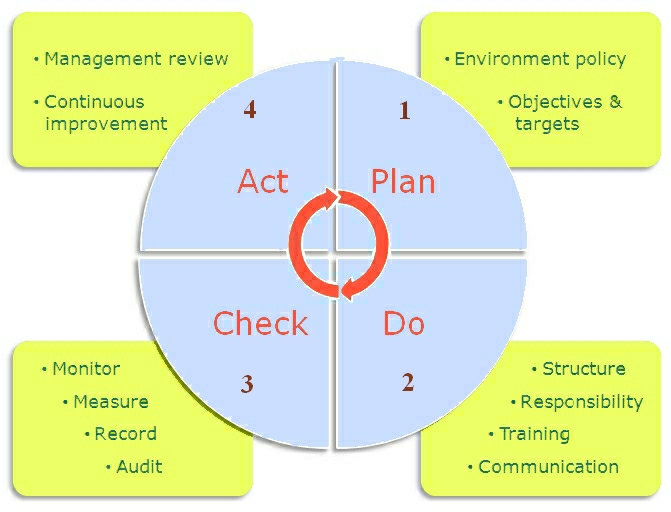| My Blog Site |  |
whsblog.com OHS and Safety | |
|
||
Plan – Do – Check – Act
PDCA
(plan–do–check–act
or
plan–do–check–adjust) is an iterative
four-step management method used in business for the control and continuous improvement of processes and products.
It is also known as the Deming
circle/cycle/wheel. PDCA was made popular by Dr W. Edwards Deming, who is considered by many to be the father of modern quality control; however, he always referred to it as the "Shewhart cycle". Later in Deming's career, he modified PDCA to "Plan, Do, Study, Act" (PDSA) because he felt that "check" emphasized inspection over analysis. PLAN Establish the objectives and processes necessary to deliver results in accordance with the expected output (the target or goals). By establishing output expectations, the completeness and accuracy of the specification is also a part of the targeted improvement. When possible start on a small scale to test possible effects. DO Implement the plan, execute the process, make the product. Collect data for charting and analysis in the following "CHECK" and "ACT" steps. CHECK / (STUDY as in PDSA) Study the actual results (measured and collected in "DO" above) and compare against the expected results (targets or goals from the "PLAN") to ascertain any differences. Look for deviation in implementation from the plan and also look for the appropriateness and completeness of the plan to enable the execution, i.e., "Do". Charting data can make this much easier to see trends over several PDCA cycles and in order to convert the collected data into information. Information is what you need for the next step "ACT". ACT / (ADJUST) Request corrective actions on significant differences between actual and planned results. Analyse the differences to determine their root causes. Determine where to apply changes that will include improvement of the process or product. When a pass through these four steps does not result in the need to improve, the scope to which PDCA is applied may be refined to plan and improve with more detail in the next iteration of the cycle, or attention needs to be placed in a different stage of the process.
Note: Some modern trainers now also refer to the "A" as "Adjust". This helps trainees to understand that the 4th step is more about adjusting/correcting the difference between the current state and the planned state instead of thinking that the "A" is all about action and implementation (which actually happens in the second ("D") stage)
|
All information is of a general nature. Readers are advied to make
their own enquiries before relying on any material in these
pages

